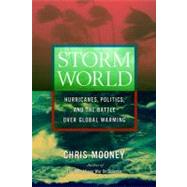
Note: Supplemental materials are not guaranteed with Rental or Used book purchases.
Purchase Benefits
What is included with this book?
| Prologue: 6229 Memphis Street | p. 1 |
| Introduction: “The Party Line” | p. 5 |
| Warming and Storming | |
| • Chimneys and Whirlpools | p. 15 |
| • Of Heat Engines . . . | p. 31 |
| • . . . and Computer Models | p. 44 |
| • “Lay That Matrix Down” | p. 59 |
| • From Hypercanes to Hurricane Andrew | |
| Boiling Over Interlude: Among the Forecasters | p. 103 |
| • The Luck of Florida | p. 109 |
| • Frictional Divergence | p. 123 |
| • Meet the Press | p. 137 |
| • “The #$%^& Hit the Fan” | p. 155 |
| • Resistance | p. 169 |
| • “Consensus” | p. 180 |
| Storm World | |
| • Preseason Warm-Ups | p. 205 |
| • Where Are the Storms? | p. 224 |
| • Hurricane Climatology | p. 245 |
| Conclusion: Home Again | p. 260 |
| Acknowledgments | p. 277 |
| The Saffir-Simpson Hurricane Scale; Note on Units of Measurement | p. 281 |
| Cyclone Typology | p. 285 |
| Early Hurricane-Climate Speculations | p. 287 |
| Consensus Statements by Participants in the World Meteorological Organization’s 6th International Workshop on Tropical Cyclones, San Jose, Costa Rica, November 2006 | p. 293 |
| Notes | p. 295 |
| Bibliography and Recommended Reading | p. 371 |
| List of Interviews | p. 377 |
| Index | p. 383 |
| Table of Contents provided by Publisher. All Rights Reserved. |
The New copy of this book will include any supplemental materials advertised. Please check the title of the book to determine if it should include any access cards, study guides, lab manuals, CDs, etc.
The Used, Rental and eBook copies of this book are not guaranteed to include any supplemental materials. Typically, only the book itself is included. This is true even if the title states it includes any access cards, study guides, lab manuals, CDs, etc.
Excerpted from Storm World: Hurricanes, Politics, and the Battle over Global Warming by Chris Mooney
All rights reserved by the original copyright owners. Excerpts are provided for display purposes only and may not be reproduced, reprinted or distributed without the written permission of the publisher.